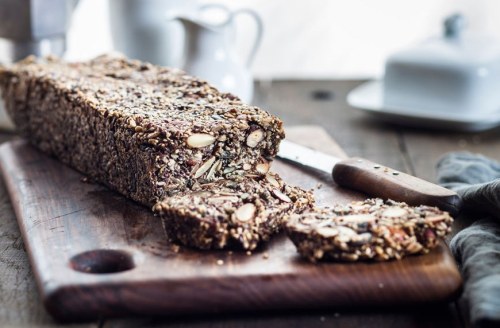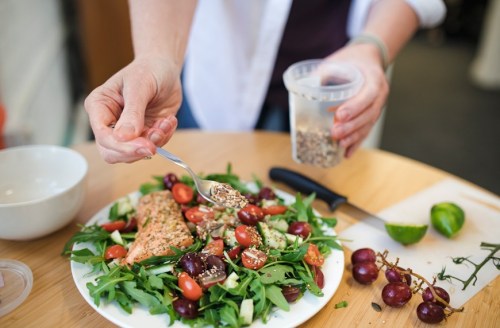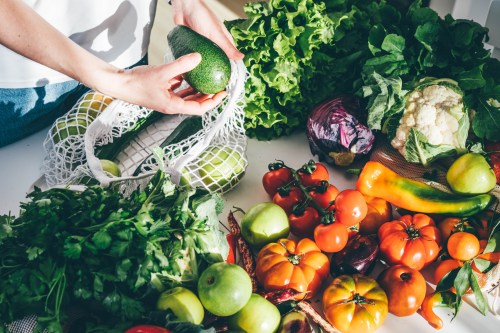Sure, flaxseed is full of fiber—but how exactly do you use it?
Health coach and author Robyn Youkilis breaks down the health benefits of flaxseed, how to store and prepare it, and which recipes to use it in.

Shiny-object syndrome is real in the wellness world—it seems like every day, there’s a new “must-have” superfood or supplement gunning for a spot in your pantry. A jar of lucuma here, some turmeric root there, and the next thing you know, your grocery budget’s been cannibalized by ingredients no one really knows how to pronounce.
Yet no matter how many new-to-us potions and powders may be hitting the shelves of Whole Foods, there’s something to be said for the basics. Flaxseed, for one, is a kitchen staple that should never be bumped from your grocery list, says health coach and digestive expert Robyn Youkilis. “I consider flaxseed to be one of the OG superfoods—before bone broth, matcha, and collagen were all popular, us health nuts were shopping for flaxseed at the health foods stores,” she says.
There’s a reason these tiny, blonde-colored seeds have been a dietary staple for the past 6,000 years, Youkilis adds. “They’re packed with magnesium, thiamine, omega-3 fatty acids, and lignans, to name a few,” she says. These superstar nutrients have been linked with better sleep, brain health, mood regulation, and hormonal balance, respectively. Suddenly, flaxseed seems a little more exciting, doesn’t it?
Keep reading for more on the health benefits of flaxseed and how to use it.

Flaxseed: An unsung digestive hero
In addition to the potential benefits mentioned above, there’s another major perk associated with flaxseed: It’s known to be amazing for your gut.
For one thing, it can help keep you regular. “Flax is full of fiber, but it specifically contains high levels of mucilage gum—a gel-forming fiber that is water-soluble and therefore moves through the gastrointestinal tract undigested,” says Youkilis. “The fiber binds to anything that needs to be swept out and pulls it through your system.” (Am I the only one who finds that visual oddly satisfying?)
But that’s not flax fiber’s only job. “Another benefit is that it can help keep food in the stomach from emptying too quickly into the small intestine,” Youkilis says. “This can increase nutrient absorption—so you get more out of the food you’re already eating—and can make you feel fuller for longer.” If weight-loss is your goal, she adds, this will make the process happen more efficiently and sustainably than cutting back on calories.

How to incorporate flaxseed into your diet
If there’s one downside to flaxseed, it’s that it’s a little high maintenance—you can’t just scoop some whole seeds out of the bulk bin and call it a day. “Whole flaxseed cannot be broken down and will pass through your digestive system unutilized,” explains Youkilis. “So you’ll want to opt for ground flax seeds or flax meal, versus simply sprinkling the whole seeds atop smoothies and salads.”
For the freshest flax possible, Youkilis recommends buying whole flax seeds and grinding them into a powder with a spice grinder whenever you want to use them. “If you can’t grind the seeds yourself, you can purchase flax meal—but only if it’s kept in the refrigerator aisle,” she adds. This is because the oils in flaxseed oxidize quickly when exposed to air. “Be sure to refrigerate the seeds and meal and use shortly after grinding.”
Another option is flax oil—it’ll give you the same health benefits as the whole seeds, but again, it’s a little temperamental. “You’ll also want to store flax oil in a cool, dark place and use it when cooking at a lower temperature to retain its nutritional properties,” Youkilis says.
Once you’ve got those rules down, flaxseed’s surprisingly anything-goes. Here, Youkilis shares a few of her favorite ways to incorporate the superseeds into her everyday cooking routine, from morning to evening to late-night snack. (Just make sure to start off slow, she says—more than 1/4 to 1/2 teaspoon to start may cause bloating and gas.)
1. Use flax meal when baking
You can add flax meal into pretty much any baked good for a nutritional boost. There are a few ways to do this: Either replace half to one cup of flour with flax meal; substitute an egg with a tablespoon of flax and three tablespoons of water mixed together; or replace every tablespoon of margarine, butter, or oil with three tablespoons of flax meal.
2. Add flax milk or ground flaxseed to smoothies
No matter which option you choose, flax is a foolproof smoothie add-in—just dump a small amount of milk or seeds into your blender and you’re good to go. (There’s no need to grind the seeds first in this case, as the blender will do it for you.) Youkilis likes to use them in place of the chia seeds in her Blueberry Pie Smoothie, but since they’re pretty neutral in flavor, you can add them to any blend. Although flaxseeds vs. chia seeds are quite similar in many ways.
3. Use flax oil in homemade salad dressing
Wherever you’d normally use olive or avocado oil, you can easily swap in flax oil. It’s a good compliment for savory and sweet dressings alike, and you don’t even need to limit it to raw veggies. Youkilis also recommends drizzling it over your proteins, fermented foods, and healthy fats, like the ones on your gut-boosting Rule of 5 Plate.
4. Stir ground flaxseed into your breakfast bowl
Ground flax is a great compliment for yogurt- and grain-based dishes, and if you mix it in well enough, you likely won’t even notice it’s there. Youkilis’ favorite flax-infused breakfasts include oatmeal, overnight oats, and fruit parfaits. Bonus: All of these options will give you an added hit of fiber, amplifying the flax’s benefits.
5. Add ground flaxseed to your homemade granola
You can get your flaxseed fix from tons of healthy, store-bought granolas, but why not up the freshness factor and DIY a batch at home? Simply stir some ground flax into your granola ingredients and toast it at low heat in the oven until it gets crispy—this 7-ingredient recipe by Daphne Oz couldn’t be simpler or more flax-friendly. Dare you not to eat it all in one sitting…
Inspired to revisit a few more health-food classics? Behold the many benefits of peppermint tea and fresh ginger.
Sign Up for Our Daily Newsletter
Get all the latest in wellness, trends, food, fitness, beauty, and more delivered right to your inbox.
Got it, you've been added to our email list.










